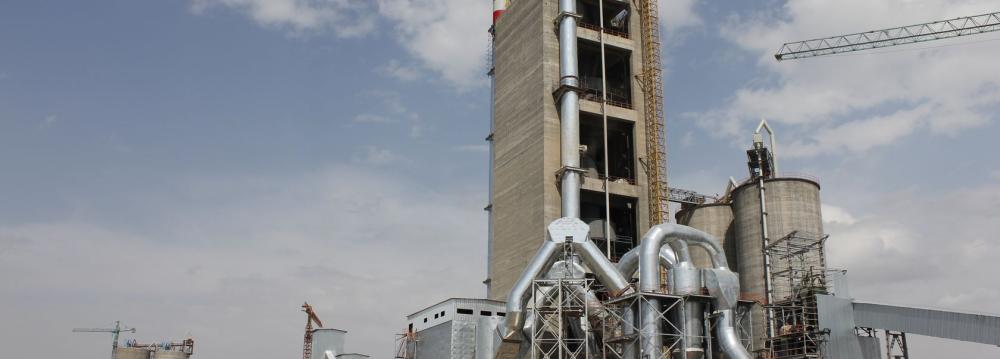Close to half of Iran’s cement producers risks bankruptcy by the yearend unless the industry’s pressing problems are addressed.
Mohammad Atabak, a member of Cement Employers Association, made the statement on Monday at a meeting of Tehran Chamber of Commerce, Industries, Mines and Agriculture the chamber’s website reported.
Shrinking oil revenues, reduced government spending, recession in the construction sector and the loss of export markets are the main woes afflicting Iran’s cement industry.
“Considering the large investments made in the cement industry in recent years and the sheer number of jobs created in the sector, urgent measures must be taken to navigate the industry out of the current crisis,” Atabak said.
Cement production has been on a downward trend, as the 2015 output reached 58.6 million tons, down 12% from the year before, according to CEA data.
Exports were also hit, diminishing from about 18 million tons to 15 million tons last year, indicating a 20% drop.
The domestic cement industry’s capacity expansion trend came to a halt in 2015 for the first time in more than 15 years, as it stayed put at 79.7 million tons per year.
The plummeting production led to a fall in Iran’s global ranking, as the country stood three steps lower in 2015 from the previous year’s fourth position among top cement producers.
Atabak noted that Iran remains the world’s top exporter, yet it is expected to give up this title soon unless it manages to find new export markets.
The Ministry of Industries, Mining and Trade has big plans for the sector. Its Strategic Plan, Iran’s most comprehensive industry-development plan in at least 15 years, was announced last August.
The plan stipulates cement output to grow 60% to reach 120 million tons per year by the end of 2025. As per the schedule, the industry is required to increase exports by 68% over the next decade to 32 million tons per annum. The plan envisioned that Iran will be able to export 21 million tons a year by 2017.
Root Causes
Prior to the current crisis, cement producers experienced a seven-year boom period because of the ill-famed Mehr Housing Scheme–a large-scale construction program initiated in 2007 by the previous administration to provide two million low-income people with housing units through free land and cheap credit.
The plan, however, slowed down due to lack of funding and dragged down domestic demand for construction materials with it. In a natural reaction, cement manufacturers turned to exports to make use of the considerable production capacities developed during the boom years.
Meanwhile, regional demand for Iranian cement declined as oil prices collapsed, causing budget and infrastructure cutbacks in some of Iran’s main export destinations, including Iraq, the UAE, Azerbaijan and Saudi Arabia.
The crisis reached a crescendo as Iraq, which accounted for nearly 65% of Iranian cement sales overseas, banned the imports of foreign cement into the country back in April to support its domestic producers.
Ever since early 2015, Baghdad has become a difficult partner for Iranian cement exporters. On top of the challenges posed by the assault of IS militants on Iraq and the consequent difficulties in goods transportation, the Iraqi government slapped an import tariff of $20 per ton on Iranian cement in September.
To bolster its local industry, Iraq turned to clinker imports. Clinker is the raw material used in the first stage of cement manufacturing at cheap prices from Iran. This led to an unprecedented rise in clinker production capacity last year, leading to overcapacity as Iraq’s demand waned gradually.
“Currently, close to 20 million tons of clinker are stored in warehouses with no demand,” according to Abdolreza Sheikhan, the head of Iran’s Cement Employers Association.
What Is to Be Done?
The industry official criticized the government’s interventionist policies when it comes to the domestic cement sector and called for the empowerment of associations and the private sector in order for them to be able to take over the domestic and export markets.
According to Atabak, government-enforced pricings not only prevented cement producers from maximizing their profits during the boom years, but made it difficult for them to weather the current recession.
The resumption of cement offerings for exports at Iran Mercantile Exchange after a four-year hiatus might be just what the industry needs as it breaks away from government intervention and allows supply and demand dynamics to determine the prices.
Isfahan Cement Company initiated the offering with 2,000 tons of the construction material last week, 1,000 tons of which were traded on cash payment.
Cement offering at the mercantile exchange began in 2010; some 1 million tons were traded and 63,000 tons were exported within the two following years. However, government-enforced pricings and the subsequent lack of competition caused cement manufacturers to become disillusioned with the exchange and pull out of IME in 2012.
The chairman of Cement Employers Association believes high value-added taxes are escalating the crisis facing the industry.
According to Sheikhan, enabling producers to pay taxes in long-term installments can ease much of the pressure.
“Cement exporters are turning away from the restricted Iraqi market toward North African countries like Kenya and Ethiopia as alternative destinations,” he said.
Sheikhan called on the government to subsidize the cost of transportation to Africa in support of the domestic industry.
Managing Director of Lamerd Cement Company Ebrahim Gholamzadeh refers to export awards as an effective way of supporting the domestic cement industry. However, the official believes cumbersome bureaucratic obstacles get in the way of designated producers who should receive these incentives.
Currently, there are two requisites for receiving export awards in general. First, annual exports must be over $50 million worth of commodities, and second the exporting firm must be a small- or medium-sized enterprise (with less than 100 workers).
Noting that most cement producers grappling with the ongoing crisis fail to meet the $50 million mark and that many of them run with more than 100 workers, Gholamzadeh called for a revision of the requisites.


